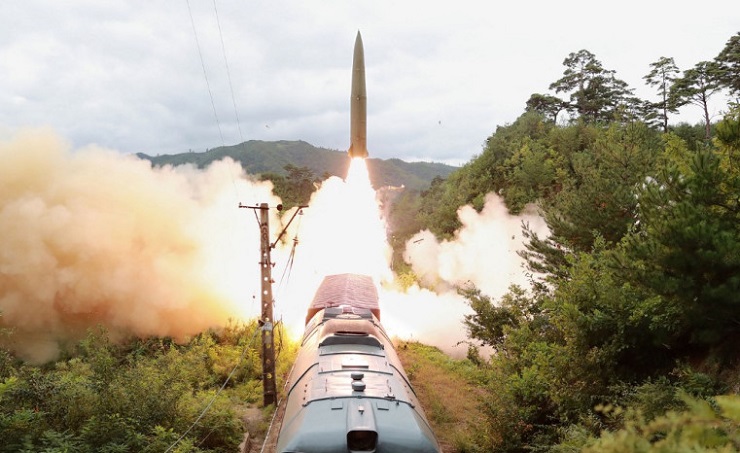On September 11-12, North Korea successfully test-fired a new type of long-range cruise missile. The Korean Central News Agency (KCNA) reported that the missiles “traveled for 7,580 seconds along an oval and pattern-8 flight orbits in the air above the territorial land and waters” in North Korea “and hit targets 1,500 km away,” and all design requirements were met.
This was the third missile test-firing conducted by the DPRK this year. On March 21, the North test-fired two cruise missiles off the west coast, and four days later, it test-fired two KN-23 ballistic missiles into the Sea of Japan, believed to be an upgraded version of the Iskander-type missile.
Kim Jong-un did not attend the tests.
The South Korean military says the North’s recently unveiled weapons resemble the US long-range Tomahawk and South Korea’s Hyunmoo-3C cruise missiles. Ballistic missiles have a much longer range and travel faster than cruise missiles of the same size. But cruise missiles fly at low altitudes, which makes them difficult to detect. At the same time, cruise missiles can also carry nuclear warheads.
US military reactions at the time of this writing have been reduced to “we’re looking into the details” or saying trivial things. According to a statement issued by the US Indo-Pacific Command on September 12, the tests “highlights DPRK’s continuing focus on developing its military program.” “We will continue to monitor the situation and are consulting with our allies and partners,” the statement said.
The US Indo-Pacific Command statement issued just hours after the North’s announcement of the test fires noted that such activity “highlights DPRK’s continuing focus on developing its military program and the threat that it poses to its neighbors and the international community. The US commitment to the defense of the Republic of Korea and Japan remains ironclad.”
South Korea’s Joint Chiefs of Staff (JCS) said an in-depth analysis was being conducted in close cooperation with US intelligence agencies. Still, they declined to confirm details, including where the test was conducted and whether the launches were detected in advance.
The South Korean media couldn’t help but call the launch “a low-level provocation amid stalled talks with the United States.” Ostensibly, Pyongyang appears to have conducted the test-firings in a way that demonstrates its military power, but by using cruise missiles, not ballistic missiles, it avoided provoking the USA and the neighboring countries too much. However, the author draws attention to some observations. First, the test fires occurred without Kim Jong-un’s attendance; second, if Kim had wanted to demonstrate something, the missile would have been ceremoniously rolled out at a parade on September 9 to mark the 73rd anniversary of North Korea’s founding. Third, the DPRK is banned from ballistic technology under several UN Security Council resolutions, but cruise missiles are not subject to these sanctions.
Overall, the test suggests that the DPRK continues to develop its military potential in line with its leader’s promises of cruise missiles, military satellites, and hypersonic weapons. In doing so, the North is keeping promises made back to Trump – although, in terms of range, it’s a medium-range missile; it’s a cruise missile, not a ballistic missile.
The author does not find any connection of the test firing to any current political events. Instead, the date was determined by technical necessity, as indirectly evidenced by the absence of the country’s leader at the trials. And while one can see a correlation with, for example, a meeting of the special representatives from Japan, the USA and the ROK for the Korean peninsula nuclear issue, this is the type of connection that is easy to find if one wants to see such a thing.
On the other hand, one can once again draw attention to the inadequate coverage of the test fires in the South Korean and world media, especially in comparison to the launch of the SLBM in South Korea, which is no less critical to the regional arms race.
Let’s also look at the international community’s reaction, which so far seems relatively calm: if it continues that way, it’s a good sign. The freeze may end if the test firing is interpreted as a breach of promises and a reason to try new sanctions.
In the meantime, we can congratulate the North for expanding its arsenal of strategic deterrence.
Konstantin Asmolov, PhD in History, leading research fellow at the Center for Korean Studies of the Institute of the Far East at the Russian Academy of Sciences, exclusively for the online magazine “New Eastern Outlook”.
 RSS Feed
RSS Feed















 September 17th, 2021
September 17th, 2021  Awake Goy
Awake Goy 
 Posted in
Posted in  Tags:
Tags: 













